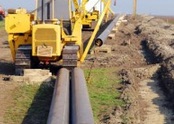 On 17 February, the EU Commission published the outcome of the call for funding under the Connecting Europe Facility (CEF), a financing tool with the aim of supporting “the development of high performing, sustainable and efficiently interconnected trans-European networks in the fields of transport, energy and digital services.” We had a deeper look into the funding instrument’s impact on energy infrastructure and found that the CEF fails to ensure efficient, and even more so, sustainable interconnections.
On 17 February, the EU Commission published the outcome of the call for funding under the Connecting Europe Facility (CEF), a financing tool with the aim of supporting “the development of high performing, sustainable and efficiently interconnected trans-European networks in the fields of transport, energy and digital services.” We had a deeper look into the funding instrument’s impact on energy infrastructure and found that the CEF fails to ensure efficient, and even more so, sustainable interconnections.
Since its creation in 2014, the CEF has provided €1billion to support gas projects, while electricity projects received only around €532million. These numbers are contrary to the declared CEF objectives of allocating the majority of its funds to electricity projects, and the EU-Commission’s own perceived need for Europe to invest further €140billion in electricity and “only” €70billion in gas infrastructure
Topsy-turvy world
Unfortunately, as in many other cases, the EU-Commission acts contrary to its declarations and aims, and it is not surprising that the latest call for CEF funding resulted in gas projects receiving another €228million, while projects in the electricity sector only received €176million. The projects that received EU money are all so-called “PCIs”, or Projects of Common Interest. Once a project is declared a PCI, it is not only eligible for funding under the CEF, it can also profit from other benefits such as accelerated permit granting procedures, a faster environmental assessment and improved regulatory treatment. To become a PCI, PCI candidates have to go through a selection process at the end of which if successful, they are included in the “Union list”, or “PCI list”. So far, two such lists have been published in 2013 and 2015, and the current list is expected to be published in fall 2017. We are closely monitoring the ongoing selection process for gas projects and the issues behind it.
The “PCI process” – what is “sustainable” about gas?
At the moment, CEF project candidates that have applied for PCI status in the third “PCI list” are being assessed. In mid-February, meetings were held at which the project candidates were presented and discussed. In order to become a PCI, a gas project must fulfil certain criteria: It has to contribute to market integration, have a cross-border impact, increase competition, improve security of supply and contribute to EU energy and climate goals.
It’s not only fulfilling this last criterion that is the tricky part. The economic benefit of almost all proposed gas infrastructure projects as well as the contribution of projects to security of supply are highly questionable: With big gas infrastructure overcapacity, the EU is already resilient to most extreme disruption scenarios and the risk of stranded assets is growing with every Euro of EU taxpayers’ money pumped into more pipelines or LNG terminals. The “sustainability” criterion that is used by a few promotors claiming that their project will be good for our climate because it replaces “dirtier” fuels with gas is simply not true. In many cases, particularly if gas is fracked gas converted to LNG, it is not significantly better for our climate than alternatives, and it often has even a significantly higher global warming potential than coal.
A not so “neutral” process…
So why are so many unnecessary gas projects still ending up on the “VIP”-list? Well, to be eligible, all projects have to be included in the TYDNP (Ten Year Network Development Plan), which gathers all those transmission development plans that are considered necessary to meet EU policy goals. The TYNDP is developed by ENTSO-G (the European Network of Transmission System Operators for Gas) – whose members are the same as those who present their PCI candidates: The transmission system operators. In order to assess which of the proposed projects finally gets a place on the PCI list, the Commission requires a cost-benefit analysis. And guess who runs this analysis? ENTSO-G!
Even though at the very end the European Parliament theoretically has its say and has to vote on the PCI list, this step is a mere rubber stamp: Deputies can only adopt or reject the entire PCI list, which contains not only all gas PCIs, but also all electricity PCIs at once. Voting against these 100+ electricity and gas projects is politically impossible.
Let’s fight this unjust process
It’s clear that the entire PCI process needs to be overhauled to deliver a real environmentally and economically sustainable energy system. We will keep following this biased process and try to make our voice heard. Soon, local groups will get the opportunity to give feedback concerning the respective PCI candidates, too, and we will do our best to support local involvement in the PCI procedure.
See the letter sent by 10 NGOs on mid-term evaluation of the Connecting Europe Facility


